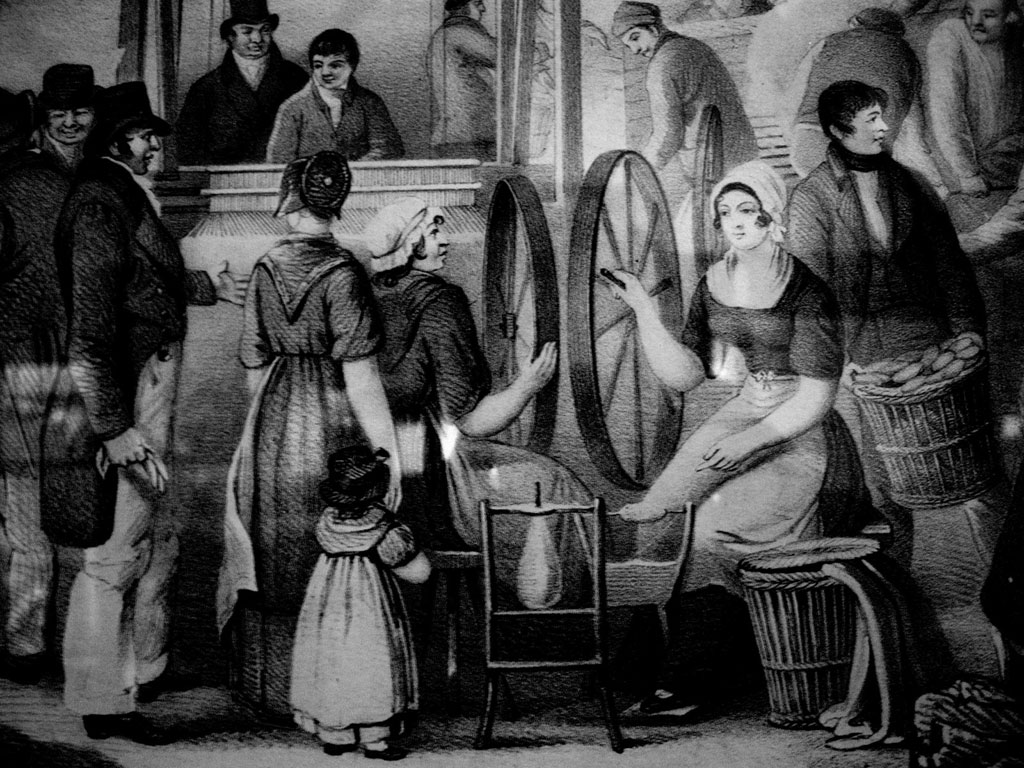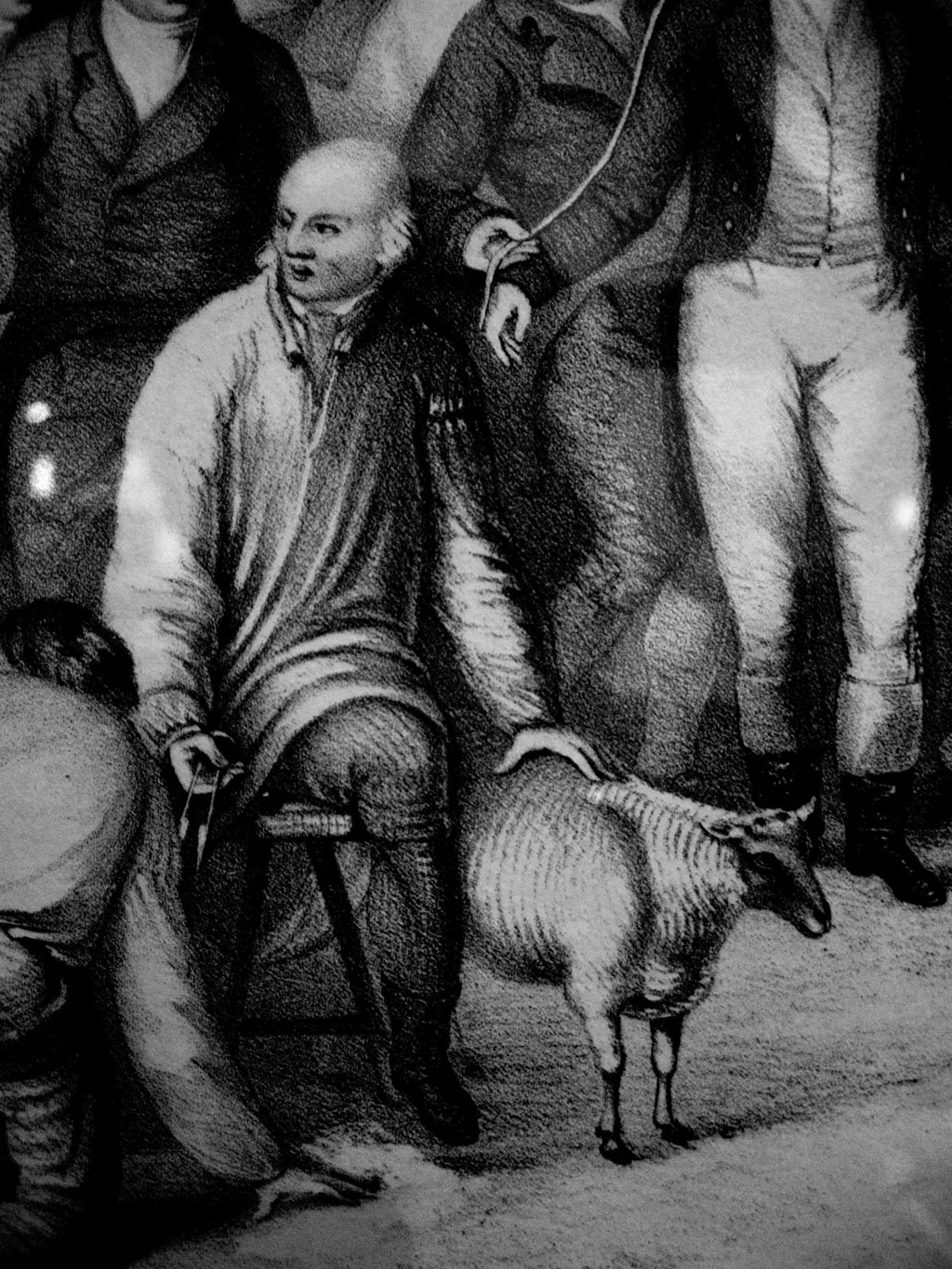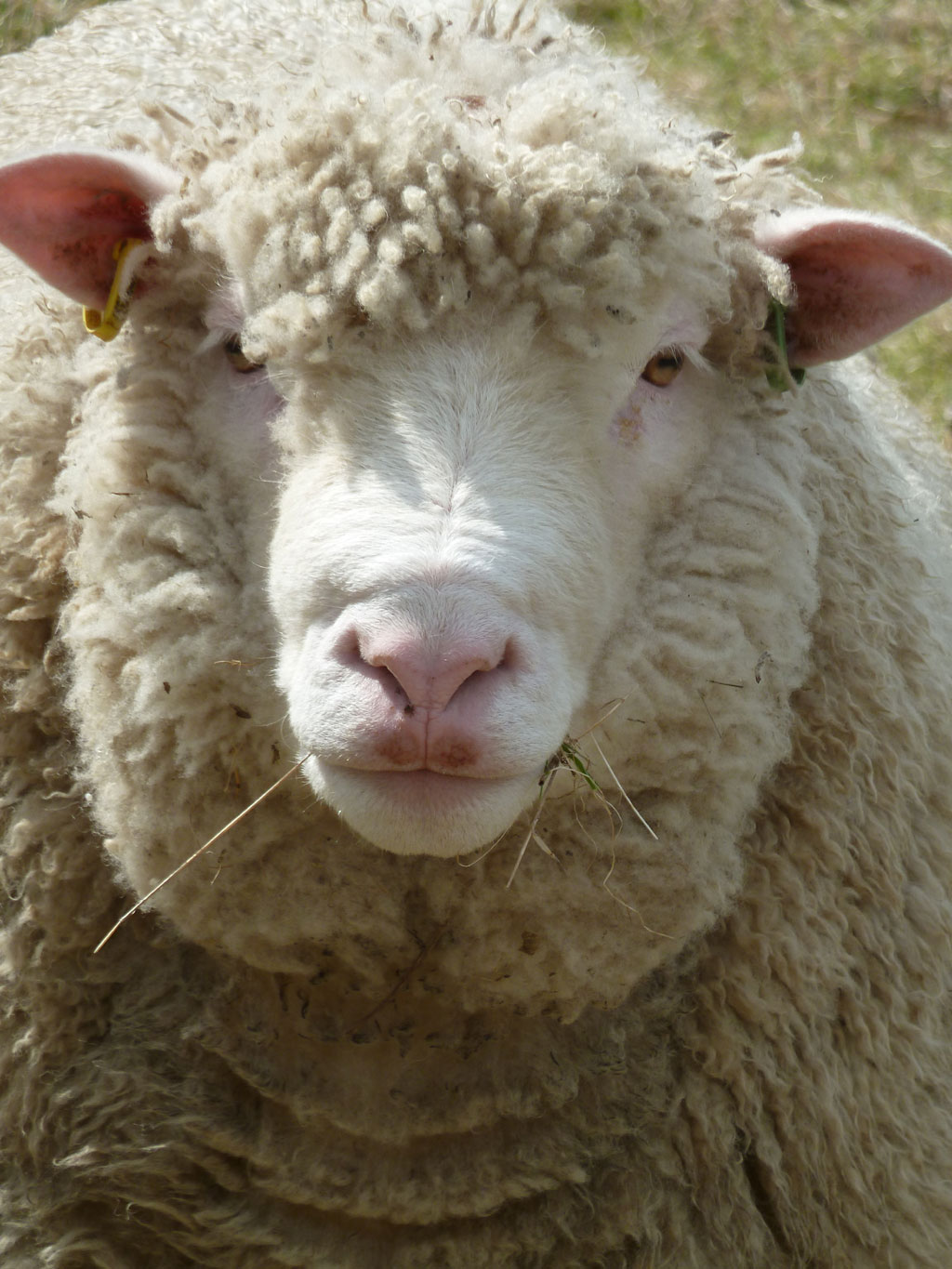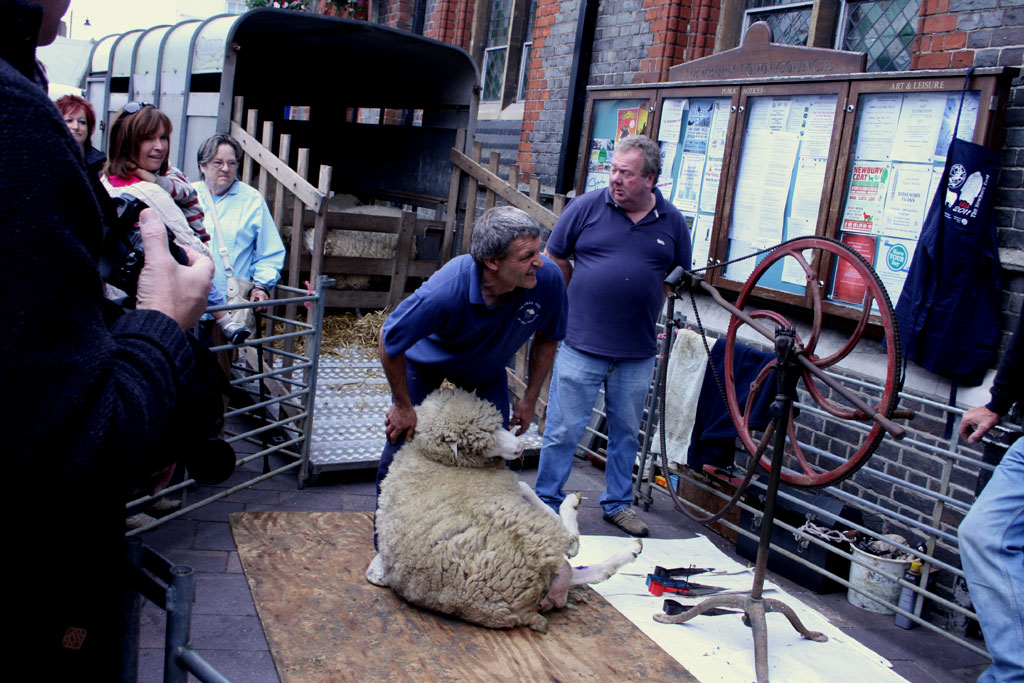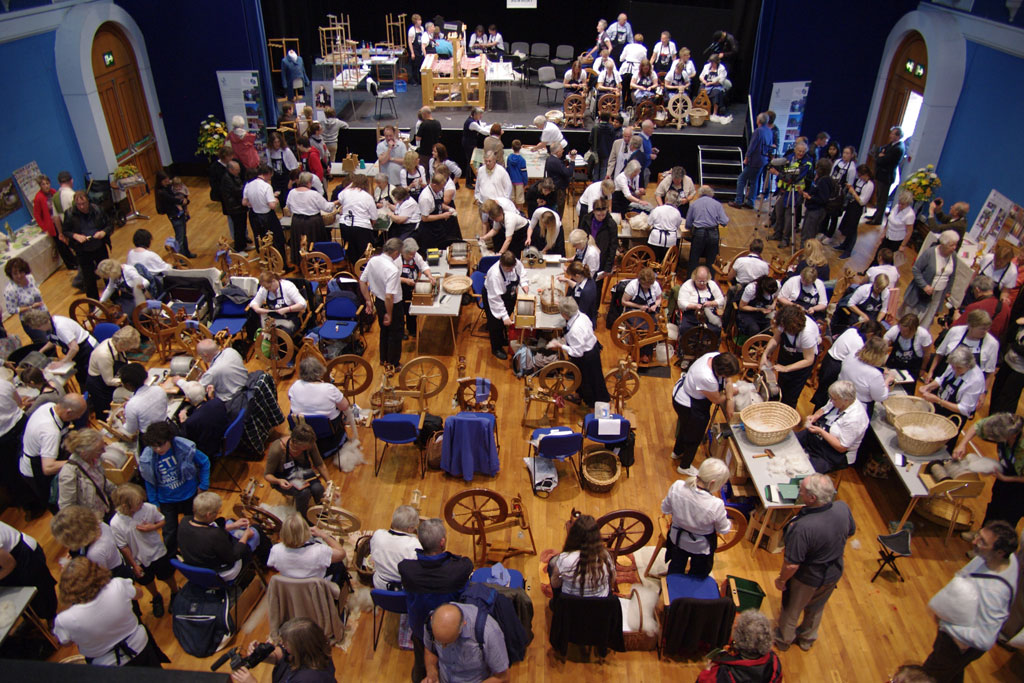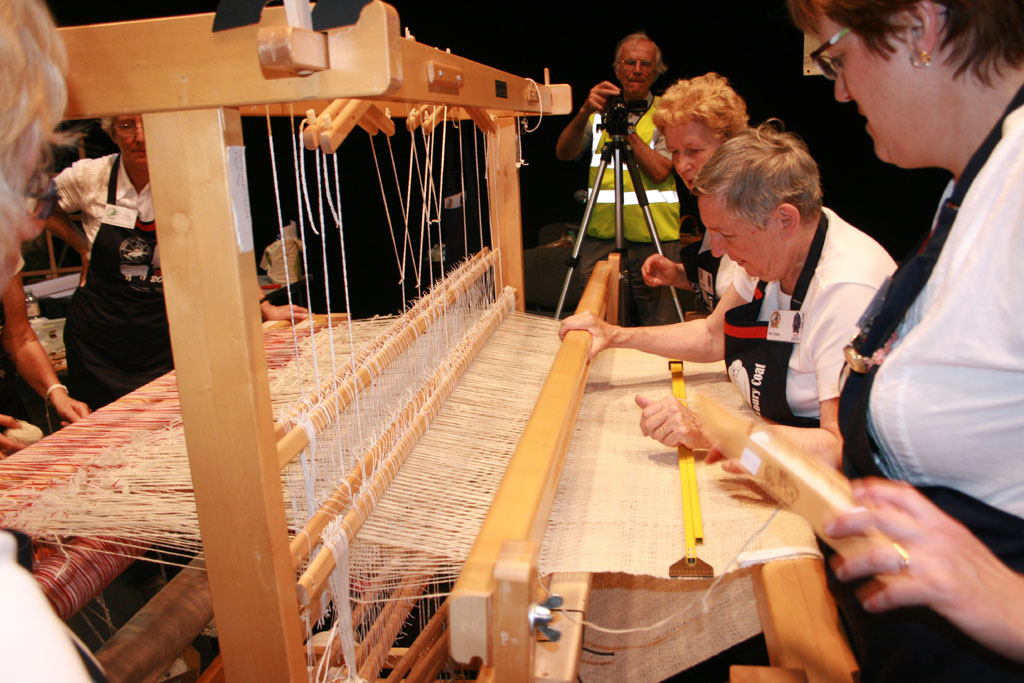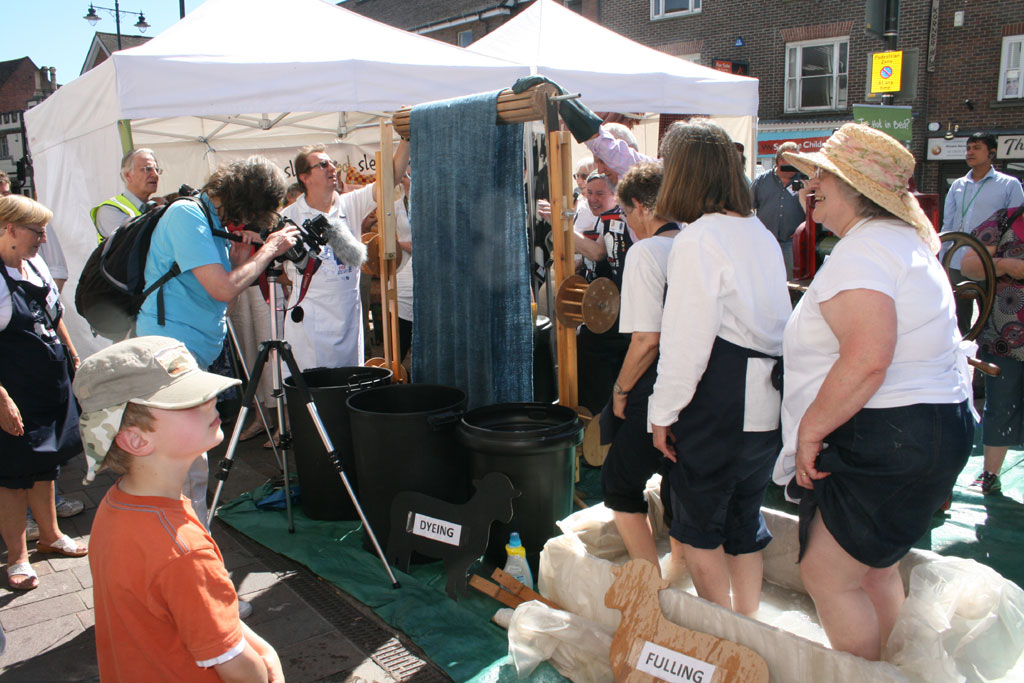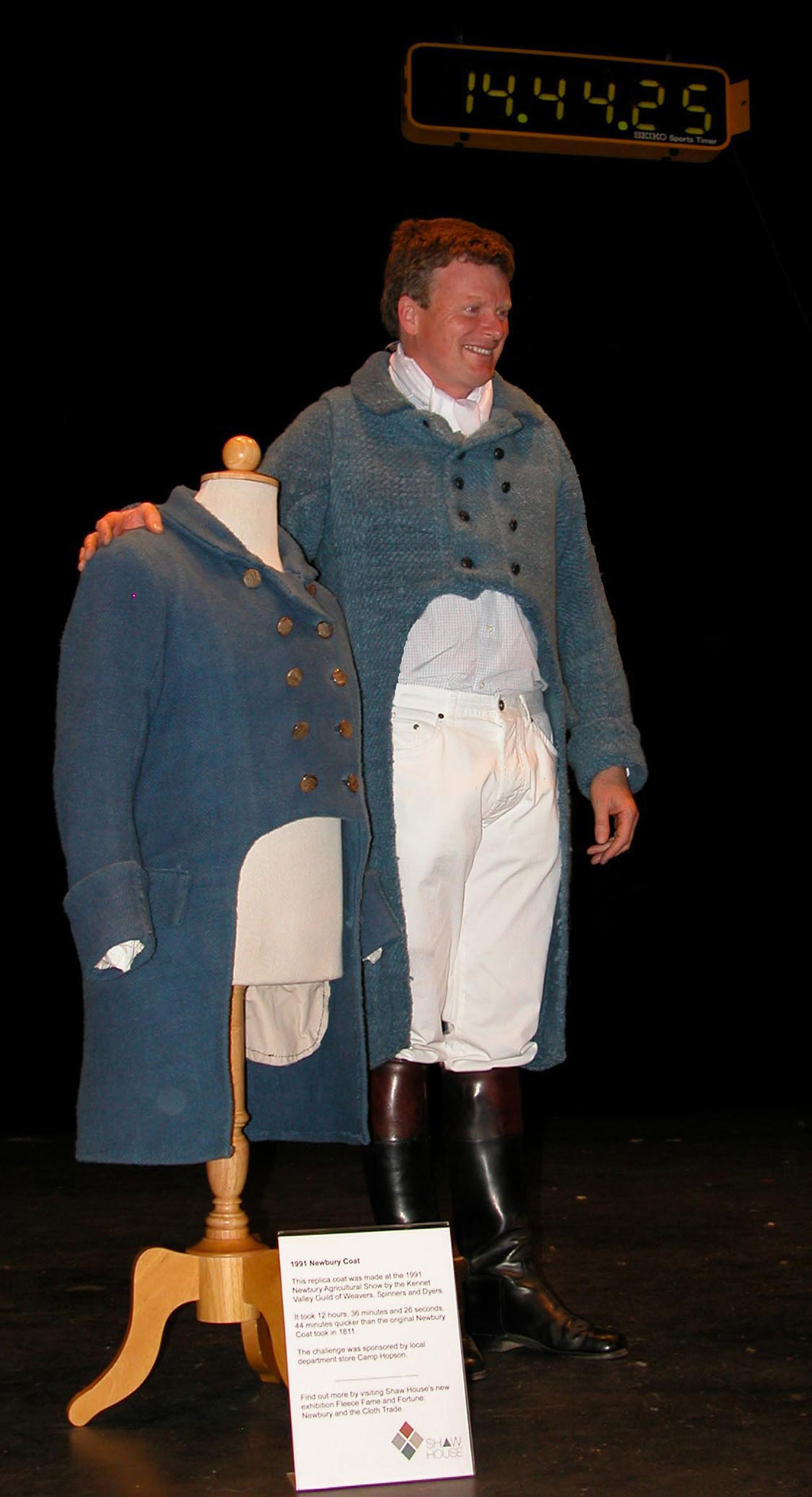Now we have had a few days of exploring how wool is processed – both domestically and commercially – we thought it would be amazing to showcase a very special project which brings all that processing together! In 2011 the Kennet Valley Guild of Weavers, Spinners and Dyers undertook a historic recreation project, based on a wager that was made in 1811, and a more recent record that was set in 1991. The idea with all three projects was to make a coat in less than 24 hours, starting with shearing the sheep!
Linda Scurr – whose wonderful 100-skeins project we heard about earlier in the month – has kindly answered all WOVEMBER’s questions about the re-making of The Newbury Coat, and has sent us some wonderful photos taken by Dennis Walker, so that you can learn about the most recent chapter in this historic sheep-to-garment tale.
To set the scene a little bit, we wanted to share a picture of a historic print which details the making of the original Newbury Coat (in 1811) and some audio, in which Richard Martin (proprietor of Cotswold Woollen Weavers) talks about the original Newbury Coat. The radio feature was produced for BBC Oxford by Felicity Ford and in it you can hear lots of sheepy sounds, as well as Richard’s lovely words about his print, and his work with wool in the Cotswolds.
[soundcloud url=”http://api.soundcloud.com/tracks/67639039″ iframe=”true” /]
This is the print to which Richard Martin refers; it documents the original creation in 1811 of The Newbury Coat
Here are the sheep in the print!
And now to our Q&A with Linda Scurr;
1. In 2011, as I understand it, the Kennet Valley Guild of Weavers, Spinners and Dyers undertook a fantastic challenge… would you be able to explain to our WOVEMBER readers what that challenge was, and the history of the idea of that challenge?
Back in 1811 John Coxeter – a mill owner in Newbury Berkshire – was boasting that with his new mill machinery he could make a coat between the hours of sunrise and sunset. His boasting was overheard by Bard Sir John Throckmorton who later, discussing it with his disbelieving dinner guests, set a wager of 1,000 guineas. On 25th June 1811 Sir John delivered some Southdown sheep to Mr Coxeter who set about completing the coat in 13 hours, 20 minutes. Kennet Valley Guild of Weavers and Spinners were asked to make a Replica coat and (without the knowledge that the original wager was about Mr Coxeter’s new machines!) set to and made a coat entirely by hand, completing a coat in 12 hours and 39 minutes. The 2011 re-enactment was a celebration of 200 years to the day and the coat was again completed in 14 hours, 44minutes and 25 seconds.
2. Obviously WOOL is of primary importance to WOVEMBER readers – what was the WOOL used in the making of the Newbury Coat?
I wanted to source fleeces from sheep local to Newbury and chose some from a local poll Dorset flock. The owner was happy to bring his sheep to the weekend and shear them by hand. Having made that decision I found out that we should have used Southdown sheep as the 1811 and 1991 coats were both made of Southdown.
poll Dorset sheep – the sheep breed used in the 2011 re-enactment of The Newbury Coat project photo © Linda Scurr
3. This website about the 2011 Newbury Coat details a very full schedule! I wondered if you could take us through it – in particular explaining some of the less familiar terms such as “waulking” and “tenters”?
The schedule on Saturday:
10:00 – the sheep arrive
10.15 – the sheep are sheared outside the Town Hall
10.30 onwards – picking, carding and combing of the wool
10.30 – the wool will start to be spun
12.00 – the weaving process will commence
The schedule on Sunday:
12.00 – the fulling and waulking of the cloth
13:00 – dyeing of the cloth / indigo and tenter hooks
14:00 – tailoring of the coat
16:00 – the coat will be finished and displayed.
The important thing about the Newbury coat was that everything was done by hand without using electricity. We started the day shearing the sheep by hand, picking the fleece over and combing it ready for the spinners.
Shearing photo, © Dennis Walker – that looks like an older model of Wolseley Sheep Shearing Machine! Links here and here
There were about 30 spinners.
Spinners, © Dennis Walker
The spinners passed their wool to the team of weavers who wove the cloth on two looms. Once the cloth was off the looms the ends and breakages were darned in.
Weavers at work © Dennis Walker
Fulling and waulking came next. When cloth comes off the loom it is quite an open structure. The cloth is dunked in a bath of soapy water and marched upon or waulked to full it. Fulling consolidates the fibres closing up the gaps between the individual threads. I am not a weaver so this description is probably not technically accurate.
Fulling, waulking (to the right) and dyeing (to the left); photo © Dennis Walker
Next came the dyeing. A natural plant dye was used (The same as used to colour jeans) Indigo oxidizes when it comes into contact with the air. The cloth came out of the dye vat yellow and turned to blue before our eyes. People watching were fascinated. Dyeing was done in Newbury Market place and we had been fore warned about not dyeing the old cobbles.
Once the cloth was fulled and dyed it was stretched on a frame to prevent it shrinking during drying. The frame is the tenter and secures the cloth with hooks all around the edge. We weren’t allowed to light a fire to heat flat irons so electric irons had to be used to dry the cloth.
4. Could you say a little bit about your own role in instigating this historic re-enactment of the making of this coat? Which bits were you especially involved in, and what are your favourite/worst memories of the experience?
I was the chairman of Kennet Valley Guild of Weavers Spinners and Dyers when we were approached to do this really important recreation. Nobody was too keen but if we didn’t do it and somebody else did, all the effort Guild members made back in 1991 would have been lost.
I have lots of really good memories. More than 100 people all worked so hard as a team and what we achieved was really special. There were thousands of visitors, we raised money for the local air ambulance and we made the coat in 14 hours 44 minutes and 25 seconds.
Richard Benyon MP wearing the 2011 coat alongside the 1991 coat, photo © Dennis Walker
There was some criticism that we didn’t set a new time record but fewer people made a much larger coat than back in 1991 and the 1991 coat was larger than the 1811 coat! I am immensely proud of the support we got and what we achieved. We got some fantastic feedback from many, many visitors; this was an event for everyone, young and old, and with newcomers and experienced spinners and weavers working alongside one another. Everyone who took part is quite rightly proud of what we did together, but they’ve all made me promise that we won’t do it again any time soon!
On the surface the weekend ran like clockwork but behind the scenes there were many problems that had to be dealt with; Venue, Funding, Publicity, recruiting volunteers and sourcing equipment were all complex tasks! It was a great weekend but as the main organiser I was very relieved when it was all over. I was on my feet non-stop all weekend and my legs and feet ached for ages!
5. Finally, as you know, WOVEMBER 2012 this year is all about closing the gap. I know that you keep sheep, process and spin fleece yourself, and so already have a very good handle of the sheep-to-garment process. However did squeezing the whole process into one weekend have a specialness or intensity when compared to the normal timings of WOOL?
Spinning and weaving are nice relaxing hobbies but this was a weekend where we had to work flat out; there was nothing relaxing about this event at all! Everyone worked incredibly hard.
Had we had more time we could have spun better wool; we could have plied and washed the wool and presented the weavers with something better to weave; we could have dried the cloth fully prior to tailoring and presented a dry coat at the end of the weekend that didn’t run the risk of dyeing all the VIP’s who wanted to model the coat blue! However it was also the intensity of the weekend that made it special. Many members of the public kept returning throughout the weekend to see how we were doing and all were in awe of just what goes into making cloth!
[youtube http://www.youtube.com/watch?v=kwYqbK2Fs2U&w=560&h=315]
Project Summary
The making of the Newbury Coat 2011
In 1811 John Coxeter, Greenham Mill owner was overheard boasting about his new machinery and his ability to turn the fleece of sheep into a coat for a man between the hours of sunrise and sunset. Sir John Throckmorton overheard this boast and with assurances from John Coxeter that it could be done set a 1000 guinea wager with his dinner guests.
25th June 1811, Southdown sheep were delivered to the mill and the coat was made in 13 hours 20 minutes. This record held until 1991 when Kennet Valley Guild of Weavers, Spinners and Dyers made a replica coat in 12 hours 39minutes.
To celebrate the 200th anniversary Kennet Valley Guild of Weavers Spinners and Dyers made another coat over the weekend of 25th and 26th June 2011 in the Market Place and Corn Exchange Theatre in Newbury, Berkshire.
The guild tracked down descendants of both John Coxeter and Sir John Throckmorton and they along with the Mayor of Newbury and the Town Crier opened the proceedings.
10 Poll Dorset sheep were shorn by hand and their fleece was run across the Market Square to a team of 30 people sorting and carding the fleece in the Corn Exchange Theatre
30 spinners spun the wool which was passed to a team of 10 weavers who used two looms.
A team of fullers and dyers dyed the two lengths of cloth in an Indigo vat in the Market Place.
The dyed cloth was stretched onto tenter hooks and ironed dry. This was the only process using electricity. (We were banned from lighting a fire to heat flat irons!)
12 tailors worked flat out cutting and sewing the coat in just over 2 hours.
The 2011 coat was completed in 14 hours, 44 minutes and 25 seconds. We didn’t set a new record but as you can see from the photo of Richard Benyon wearing the coat alongside the 1991 coat fewer people made a much larger coat.
The 2011 coat is a major achievement and one that all the participants can be truly proud of.
Great thanks to Linda Scurr and all the members of the Kennet Valley Guild of Weavers, Spinners & Dyers – what an amazing project to have been involved with, and indeed what a powerful reminder of the labour and process which lie behind WOOLLEN TEXTILES! All the answers in this Q&A © Linda Scurr, and all the photos – unless otherwise stated – © Dennis Walker. All content used with the kind permission of Linda Scurr. You can read more about this amazing project in Edition no. 5 of YarnMaker Magazine
